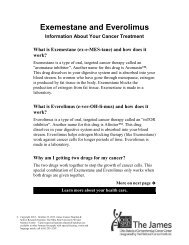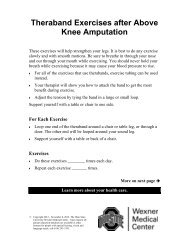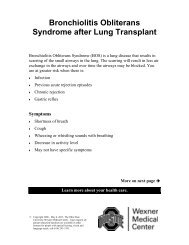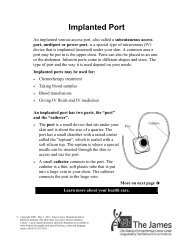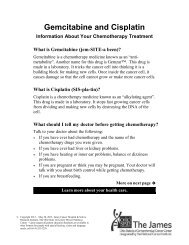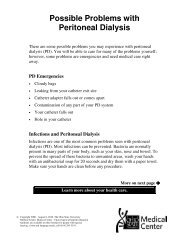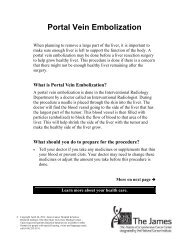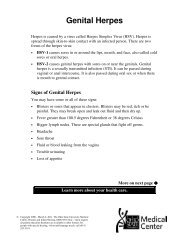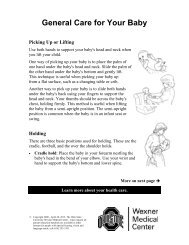Bartholin Cyst or Abscess - Patient Education Home - The Ohio ...
Bartholin Cyst or Abscess - Patient Education Home - The Ohio ...
Bartholin Cyst or Abscess - Patient Education Home - The Ohio ...
You also want an ePaper? Increase the reach of your titles
YUMPU automatically turns print PDFs into web optimized ePapers that Google loves.
<strong>Bartholin</strong> <strong>Cyst</strong> <strong>or</strong> <strong>Abscess</strong><br />
<strong>The</strong>re is one <strong>Bartholin</strong> gland on each<br />
side of the labia. <strong>The</strong> labia are the<br />
large skin folds on each side of the<br />
vagina. This gland releases fluid<br />
through a passage called a duct into<br />
the vagina.<br />
A cyst is caused when the duct<br />
opening gets clogged. <strong>The</strong> fluid is not<br />
able to get out which causes a lump<br />
and pain.<br />
When the gland becomes infected, it<br />
is called an abscess.<br />
What causes a <strong>Bartholin</strong> cyst <strong>or</strong> abscess?<br />
<strong>The</strong> abscess can be caused by infection, such as gon<strong>or</strong>rhea. It also may<br />
occur with an injury to the vaginal area. Sometimes the cause f<strong>or</strong> a cyst<br />
<strong>or</strong> abscess is not known.<br />
Signs of a <strong>Cyst</strong><br />
If you have any of these signs, see your doct<strong>or</strong> f<strong>or</strong> treatment:<br />
• Swelling <strong>or</strong> a lump near the opening of the vagina<br />
• Cloudy, brown, <strong>or</strong> yellow drainage when pressure is put on the lump<br />
• Pain when walking, sitting <strong>or</strong> having sex<br />
• Fever, but this is a less common sign<br />
© Copyright (2000 - 1/19/2010) Emergency Department and the OB /<br />
GYN Clinic, <strong>The</strong> <strong>Ohio</strong> State University Medical Center - Upon<br />
request all patient education handouts are available in other f<strong>or</strong>mats<br />
f<strong>or</strong> people with special hearing, vision and language needs, call (614)<br />
293-3191.<br />
Learn m<strong>or</strong>e about your health care.<br />
M<strong>or</strong>e on next page
Page 2<br />
Treatment<br />
Treatment may depend on how large the cyst is <strong>or</strong> whether you have an<br />
infection <strong>or</strong> abscess. Your treatment may include:<br />
• Placing warm moist towels on the vaginal area<br />
• Sitting in warm water, not hot, without soap<br />
• Taking medicine called antibiotics to fight infection, if needed<br />
• An incision <strong>or</strong> cutting the cyst to drain the gland using a small<br />
drainage tube called a catheter in the doct<strong>or</strong>’s office <strong>or</strong> clinic<br />
• Removing the cyst <strong>or</strong> abscess with surgery<br />
To Drain <strong>or</strong> Remove the <strong>Cyst</strong><br />
Sometimes, the cyst needs to be opened and fluid drained, <strong>or</strong> it needs to<br />
be removed.<br />
• With your feet in metal stirrups, the area between your legs will be<br />
cleaned with an antiseptic called Betadine and water. This soap may<br />
make your skin yellow.<br />
• You may be given a numbing medicine <strong>or</strong> pain medicines to feel<br />
comf<strong>or</strong>table during the procedure.<br />
• Your doct<strong>or</strong> will open the cyst to allow the fluid to come out. A<br />
small tube called a catheter may be placed into the cyst to help it<br />
drain. <strong>The</strong> catheter stays in place f<strong>or</strong> several weeks. <strong>The</strong> doct<strong>or</strong> then<br />
removes it, although if it falls out bef<strong>or</strong>e your follow up visit, that is<br />
okay.<br />
• <strong>The</strong>re is a chance that you may bleed <strong>or</strong> get an infection. <strong>The</strong>se<br />
problems are often easy to treat with medicines.<br />
Follow-up Care<br />
It is imp<strong>or</strong>tant to see a health care provider to make sure you are<br />
healing well after treatment.<br />
• Schedule a follow up appointment at the OSU Obstetrics and<br />
Gynecology Clinic at (614) 293-8045 as directed by your doct<strong>or</strong>.
Page 3<br />
• After treatment, if your pain gets w<strong>or</strong>se <strong>or</strong> you have a fever with a<br />
temperature of 100 degrees <strong>or</strong> higher, call the OSU OB/GYN Clinic<br />
at (614) 293-8045. If the clinic is closed, you need to be seen by a<br />
doct<strong>or</strong> in a care center <strong>or</strong> emergency room.<br />
• You may have sex as soon as the pain and tenderness are gone.<br />
• If you had an infection passed by sexual intercourse, do not have<br />
sex until both you and your partner have been treated and finished<br />
your antibiotics.<br />
• Use a condom to prevent the spread of sexually transmitted<br />
infections.<br />
Prevention Tips<br />
• Use good personal cleanliness, such as wiping front to back after a<br />
bowel movement.<br />
• Do not use vaginal sprays, deod<strong>or</strong>ant <strong>or</strong> douches.<br />
• Wear loose fitting cotton underwear.<br />
• Avoid wearing tight panty hose <strong>or</strong> pants.<br />
• Use condoms to prevent infections during sex.<br />
Talk to your doct<strong>or</strong> <strong>or</strong> others on your health care team if you<br />
have questions. You may request m<strong>or</strong>e written inf<strong>or</strong>mation<br />
from the Library f<strong>or</strong> Health Inf<strong>or</strong>mation at (614) 293-3707 <strong>or</strong><br />
email: health-info@osu.edu.



